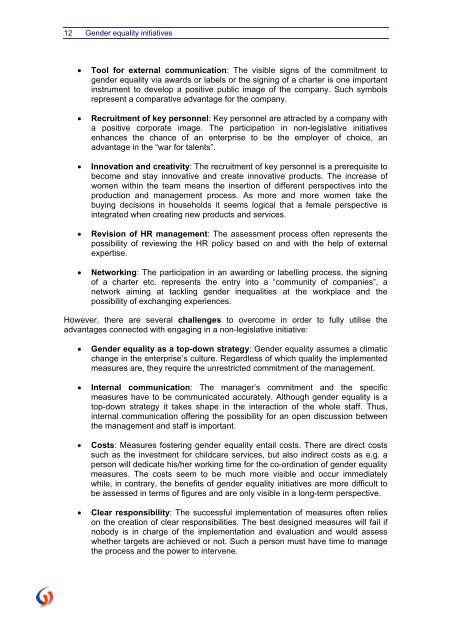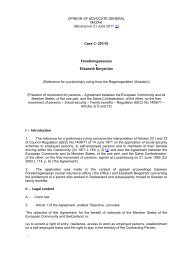Study on non-legislative initiatives for companies to promote gender ...
Study on non-legislative initiatives for companies to promote gender ...
Study on non-legislative initiatives for companies to promote gender ...
Create successful ePaper yourself
Turn your PDF publications into a flip-book with our unique Google optimized e-Paper software.
12 Gender equality <strong>initiatives</strong><br />
• Tool <strong>for</strong> external communicati<strong>on</strong>: The visible signs of the commitment <strong>to</strong><br />
<strong>gender</strong> equality via awards or labels or the signing of a charter is <strong>on</strong>e important<br />
instrument <strong>to</strong> develop a positive public image of the company. Such symbols<br />
represent a comparative advantage <strong>for</strong> the company.<br />
• Recruitment of key pers<strong>on</strong>nel: Key pers<strong>on</strong>nel are attracted by a company with<br />
a positive corporate image. The participati<strong>on</strong> in n<strong>on</strong>-<strong>legislative</strong> <strong>initiatives</strong><br />
enhances the chance of an enterprise <strong>to</strong> be the employer of choice, an<br />
advantage in the “war <strong>for</strong> talents”.<br />
• Innovati<strong>on</strong> and creativity: The recruitment of key pers<strong>on</strong>nel is a prerequisite <strong>to</strong><br />
become and stay innovative and create innovative products. The increase of<br />
women within the team means the inserti<strong>on</strong> of different perspectives in<strong>to</strong> the<br />
producti<strong>on</strong> and management process. As more and more women take the<br />
buying decisi<strong>on</strong>s in households it seems logical that a female perspective is<br />
integrated when creating new products and services.<br />
• Revisi<strong>on</strong> of HR management: The assessment process often represents the<br />
possibility of reviewing the HR policy based <strong>on</strong> and with the help of external<br />
expertise.<br />
• Networking: The participati<strong>on</strong> in an awarding or labelling process, the signing<br />
of a charter etc. represents the entry in<strong>to</strong> a “community of <strong>companies</strong>”, a<br />
network aiming at tackling <strong>gender</strong> inequalities at the workplace and the<br />
possibility of exchanging experiences.<br />
However, there are several challenges <strong>to</strong> overcome in order <strong>to</strong> fully utilise the<br />
advantages c<strong>on</strong>nected with engaging in a n<strong>on</strong>-<strong>legislative</strong> initiative:<br />
• Gender equality as a <strong>to</strong>p-down strategy: Gender equality assumes a climatic<br />
change in the enterprise’s culture. Regardless of which quality the implemented<br />
measures are, they require the unrestricted commitment of the management.<br />
• Internal communicati<strong>on</strong>: The manager’s commitment and the specific<br />
measures have <strong>to</strong> be communicated accurately. Although <strong>gender</strong> equality is a<br />
<strong>to</strong>p-down strategy it takes shape in the interacti<strong>on</strong> of the whole staff. Thus,<br />
internal communicati<strong>on</strong> offering the possibility <strong>for</strong> an open discussi<strong>on</strong> between<br />
the management and staff is important.<br />
• Costs: Measures fostering <strong>gender</strong> equality entail costs. There are direct costs<br />
such as the investment <strong>for</strong> childcare services, but also indirect costs as e.g. a<br />
pers<strong>on</strong> will dedicate his/her working time <strong>for</strong> the co-ordinati<strong>on</strong> of <strong>gender</strong> equality<br />
measures. The costs seem <strong>to</strong> be much more visible and occur immediately<br />
while, in c<strong>on</strong>trary, the benefits of <strong>gender</strong> equality <strong>initiatives</strong> are more difficult <strong>to</strong><br />
be assessed in terms of figures and are <strong>on</strong>ly visible in a l<strong>on</strong>g-term perspective.<br />
• Clear resp<strong>on</strong>sibility: The successful implementati<strong>on</strong> of measures often relies<br />
<strong>on</strong> the creati<strong>on</strong> of clear resp<strong>on</strong>sibilities. The best designed measures will fail if<br />
nobody is in charge of the implementati<strong>on</strong> and evaluati<strong>on</strong> and would assess<br />
whether targets are achieved or not. Such a pers<strong>on</strong> must have time <strong>to</strong> manage<br />
the process and the power <strong>to</strong> intervene.
















